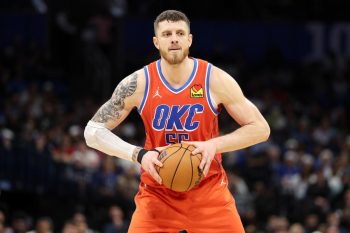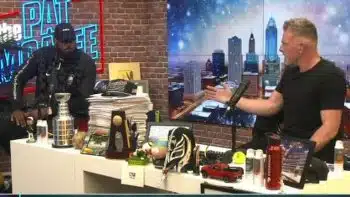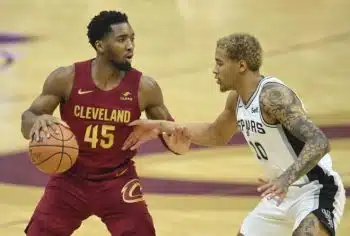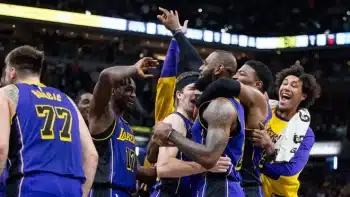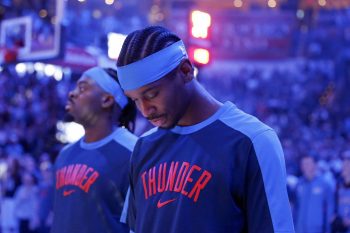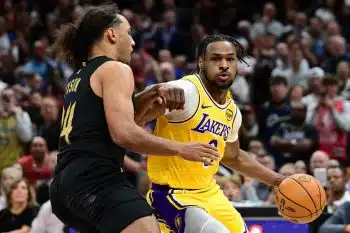NBA
Jeff Withey: Forgotten Man Flourishing
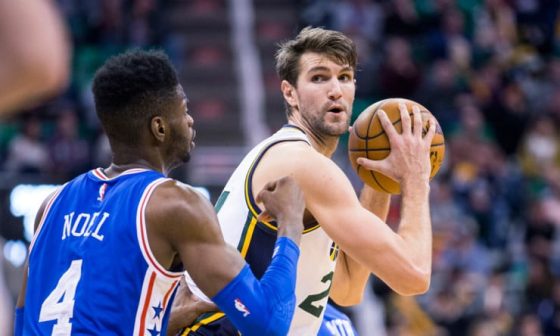
The NBA’s middle and bottom tiers often aren’t as glamorous as one might like to believe. Paupers they aren’t, but the ratio of struggle to compensation for guys in the league’s proletariat typically pales in comparison to their star counterparts. This is especially true for those on the margins, competing for roster spots and minimum salary guarantees – the cut potential is high, the reward for success is (relatively) low, and the job stakes are sky high given how far the financial benefits fall off a cliff for those who fall short.
Guys can fall through the cracks easily during this process. After all, with limited time available in training camps and preseason play to determine who deserves end-of-bench slots and hundreds of other things on the minds of coaches and team brass, a couple ill-timed, uncharacteristic mistakes could mean the difference between a contract and a tour back around the D-League.
Near the midpoint of his third NBA season, Utah’s Jeff Withey is looking more and more like a guy who somehow slipped through everyone’s fingertips. He was among the token “good efficiency, tiny sample” examples during his first two seasons in New Orleans – players for whom it’s tough to tell whether their strong play in limited situations would transfer into a larger role without a loss in productivity.
The Pelicans faded this possibility in letting Withey go, and they quickly look to be on the losing side of that proposition. Withey has stepped admirably into a void filled by injuries to Rudy Gobert and Derrick Favors, posting a career-best 19 PER in by far the largest role he’s been asked to play. He’s shooting nearly 56 percent from the field and blocking over three shots per-36-minutes on the floor, a badly needed continuation of the rim protection provided by Gobert and Favors that serves as the foundation of Utah’s defense.
“It just took a chance for me to get on the floor,” Withey told Basketball Insiders. “Even in New Orleans, whenever I had a chance to play, I was able to put up decent numbers. So it was just a matter of being on the floor.”
Such opportunities were hard to come by for Withey with the Pelicans. Initial signs were promising in his rookie year, during which he logged nearly 12 minutes a night in 58 games and showcased the outlines of a capable interior defender at the NBA level. There were nights where he dressed and didn’t play, natural for a rookie behind other talent at his position. A couple injuries allowed him more significant time, which he relished.
“Jason Smith, that was my rookie year, he got hurt,” Withey said. “So I was starting the last, I don’t know, three games of the year. And that kind of gave me confidence going into the year after that [2014-15]. I didn’t play a whole lot, but I knew in the back of my mind that I could play.”
That cautious optimism would be the rosiest things got for Withey in New Orleans, however. Buried behind Omer Asik and Alexis Ajinca on the center depth chart, his minutes decreased to just seven a night in his second season as he spent long periods fully outside the rotation. His production remained similar and even heightened in certain areas, but even as he outplayed both guys ahead of him in a couple major areas given their roles, he couldn’t find any consistent playing time. He logged DNP-CD designations during over a quarter of the Pelicans’ games last season.
Worse yet, the lack of confidence in Withey seemed to show through at the managerial level in New Orleans also. At best, it seems the two sides weren’t on the same page. At worst, Withey may have been misled to some degree.
“With New Orleans, they told me that I was going to get picked up the year before, in the [2015] playoffs,” Withey said. “I remember talking to the GM, Dell Demps, and he was like, ‘Hey, we’re going to pick up your option. We know you’re not playing a whole lot this year, but we want you back here.’ So going into the summer, I was not too worried about anything.”
That’s where things went awry.
“They did give me my offer, [but] then took it back after a couple weeks,” Withey said. “Once that happened, I was just really confused.”
To be clear, a team renouncing a player’s restricted offer isn’t against any rules and can often be standard practice. But the assurances made to Withey, combined with a very low guaranteed salary figure and his strong play while on the floor, make it fair to wonder whether things were fully above board for Withey with Pelicans management – something other executives have speculated on privately.
Once he hit the open market, it wasn’t only the Pelicans who seemed curiously lukewarm on the former Kansas product. He languished into mid-August with very little interest, a time where Withey says phone calls to agent Darren Matsubara wondering what was going on were frequent. Teams showed bits of interest, but were unwilling to offer any guaranteed salary.
“They wanted me to come to training camp and kind of prove myself,” Withey said.
Finally, in late August, the Jazz came calling. As one of the first teams to explore offering small guaranteed figures to fringe players as a way to incentivize them to sign and remain with the program, the Jazz had already found a couple diamonds in the rough under GM Dennis Lindsey; Withey would become the next one. Utah offered $200,000 in guaranteed money along with the understanding that Withey would still have to earn his roster spot, and this guarantee plus what Withey and Matsubara saw as a great fit in Utah did the trick. He had a new home.
And while it wasn’t quite immediate, Withey has proven he belongs. He beat out summer signee Tibor Pleiss for backup center minutes whenever Gobert or Favors wasn’t available before being thrust into a much larger role as both starting frontcourt players sustained injuries within a few weeks of each other. Suddenly he’s started nine games for a playoff team, more than double his career total coming into the year, and he’s quickly proving that his small sample size was more a result of ignorance above him than any issue with his play. The Jazz are outscoring teams by 5.2 points per-100-possessions while he plays, easily the best mark of any Utah regular outside Gobert.
Apart from his raw numbers, which are impressive on their own, Withey’s largest impact has been as a rim protector in Gobert’s absence. He’s allowing a hair under 40 percent while contesting opponent shots at the rim, per SportVU data, one of just three qualified players in the league doing so – the others are Gobert himself and Serge Ibaka. Per more advanced figures from Nylon Calculus, Withey is “saving” the fourth-most points in the NBA for his team on a per-minute basis when factoring in positional context – he prevents an estimated 7.7 points at the rim per-36 compared to the league average center.
“It’s just something that comes out of habit, out of just who I am,” Withey said of his skill as an interior defender. “In college, that’s what I did. And then in the pros, it’s not that much different – you’ve got three in the key defensively, but I think it’s just being quick off your feet and try to not really be afraid of getting dunked on or anything [is still what’s important]. Just attacking the ball.”
Having Gobert in the same locker room can’t hurt; Withey says he and Rudy compare notes often as rim protectors. And with the big Frenchman finally returned from an MCL injury, Withey’s emergence allows Jazz coach Quin Snyder the chance to keep an elite rim protector on the floor at all times – he did exactly that in a big win over Miami Saturday night and again in Los Angeles Sunday. The Jazz already have a scheme that asks only Withey’s best qualities of him.
“He’s always been a shot blocker,” Snyder said. “We don’t need him to be a low-post offensive scorer, but if he can finish the way he has and make free throws, that’s the main thing.”
Snyder and the rest of the Jazz coaching staff continue to be very impressed with Withey’s work ethic and preparedness, something he freely admits was honed in part during the rough times in New Orleans. He trained himself to be ready when called upon, even if that might be extremely irregularly, and it’s paying off.
The experience has been a total reversal from his first couple seasons. The Jazz have a fantastic locker room culture, one Withey fits nicely into on a similar age track as the team’s other burgeoning talent. He also feels a connection with Snyder and the staff that simply wasn’t present previously.
“The coaches here are amazing,” he told Basketball Insiders. “They give you a lot of confidence.”
The contrast was stark to his previous home.
“In New Orleans, it was a tough place for me, just because the coach [Monty Williams], he didn’t really give me a shot, you know what I mean? Even if I was playing, if I screwed up one time or anything like that, he would just take me right out. Here, Coach [Snyder], he’ll come to you… it’s just a different type of coaching. More player-friendly, for sure.”
Withey has a ways to go yet as a finished product, to be sure. He’s working dutifully on his jump-shooting, perfecting a 15-footer and even launching corner threes in warmups with some success. He knows the game is trending in that direction. Likewise, he’s heard the call from Jazz brass to bulk up a bit over the upcoming offseason, even speculating that fluctuating weight may have contributed to how long he remained on the waiver pile last summer.
All signs point to Withey as a man on the rise, though. He remains on a non-guaranteed deal with Utah for next season, but his production relative to his salary makes the Jazz cutting him feel nearly impossible barring unexpected developments. He’ll be square in his prime at 27 years old as he hits the open market following the 2016-17 season, and whether it’s in Salt Lake City or elsewhere, he’s proven he belongs at this level. All he needed was the right opportunity.
“Sometimes that’s what you need,” Snyder said of his latest reclamation project. “You can talk about development, but opportunity [is key].”
